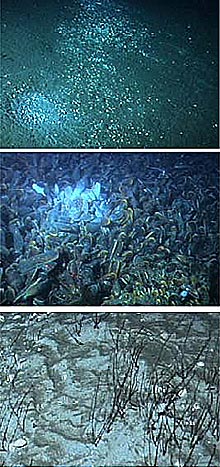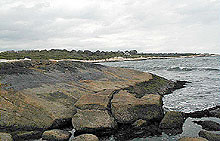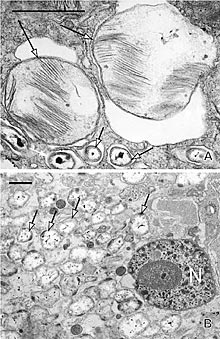
Blake Ridge Diapir clam beds, mussel beds, and tubeworm fields, all located within a few meters of one another without overlap. Click image for larger view.
Zoning Laws: Windows to the Deep
Chemosynthetic Relationship
Dr. Cindy Van Dover
co-Chief Scientist
Marjorie S. Curtis Associate Professor
College of William and Mary
Imagine diving to a deep-sea chemosynthetic (derives energy from chemical reactions) ecosystem in the Alvin submersible. Apart from the wonder of seeing an oasis of animal life in the middle of seemingly barren mudflats or lava fields, one of the most striking features you are likely to note is the abrupt transition between populations of different vent or seep species.
At the Blake Ridge Diapir (what's a diapir?) ![]() seep site, for example, there is no overlap between clam beds and mussel beds. The fields of worms in tubes occupy yet another piece of real estate. In many ways, this kind of zonation of organisms in chemosynthetic ecosystems is similar to the horizontal zonation of organisms that should be familiar to anyone who has climbed over the rocky intertidal zone.
seep site, for example, there is no overlap between clam beds and mussel beds. The fields of worms in tubes occupy yet another piece of real estate. In many ways, this kind of zonation of organisms in chemosynthetic ecosystems is similar to the horizontal zonation of organisms that should be familiar to anyone who has climbed over the rocky intertidal zone.

Black Point (Narragansett Bay, Rhode Island) rocky intertidal zonation. Horizontal banding is evident on the exposed rocks at low tide.Click image for larger view.
As one descends a typical rocky shoreline, a black lichen zone gives way to a zone of periwinkle snails, then to a band of barnacles, and finally to mussels. Decades of observation and experimentation in the rocky intertidal have taught us that at the upper levels of the intertidal, physical factors such as tolerance to desiccation (drying out), heat stress, and wave shock may determine which species survive there. Biological interactions—especially competition for space, predation, and toleration of stressful conditions—also play important roles in determining zonation patterns, especially in the lower intertidal zones.

Endosymbionts of Blake Ridge bivalves. A: Methanotrophic (large arrows) and sulfide-oxidizing (small arrows) bacteria in mussel gills. B: Sulfide-oxidizing bacteria (arrows) in clam gill cells. N = nucleus; scale bars = 1 _m. Click image for larger view.
There is a reason why clams are in one place and mussels are in another at the Blake Ridge Diapir. It is the ecologist’s task to understand what controls the location of these zones. The clams and mussels both have sulfide-oxidizing bacteria as endosymbionts (organisms that live within another in a mutually beneficial relationship) in their gills. Because the clams and the mussels host these bacteria in their gills and derive most, if not all, of their nutrition from these bacteria, we must consider the requirements and tolerances of the bacteria as well. To keep these bacteria productive, the bivalves must live where sulfide is readily available.
The mussels have a second type of endosymbiotic bacteria, one that requires methane. Thus, the mussels seem likely to prefer sites where both sulfide and methane are readily available. The ecologist needs to describe the chemical environment favored by each species. He or she starts with the hypothesis that there is no difference between the two and then collects enough samples to determine with some statistical reliability whether this null hypothesis is true or false.
While chemical data will provide insight into what controls distributions of invertebrate species at the Blake Ridge Diapir, other factors also may be involved. For instance, while it may be reasonable to hypothesize that the mussels do not live where the clams do because the clam habitat lacks sufficient methane, why don’t the clams live where the mussels live? Is it because the mussels outcompete the clams for the available sulfide? Are high levels of methane toxic to the clams? Is there some other factor associated with mussel beds that prevents clam larvae from settling or surviving there?
We are optimistic that the distributions of the clams, mussels, worms and other invertebrate types will provide us with information about what is going on below the surface of the sea floor. By exploring and sampling new sites, we will determine whether the invertebrates provide a reliable code for differing chemical environments.


















